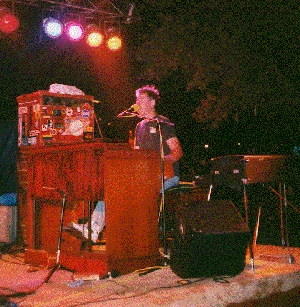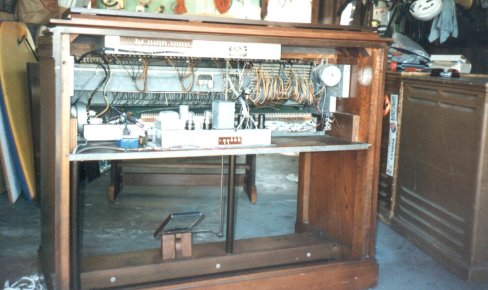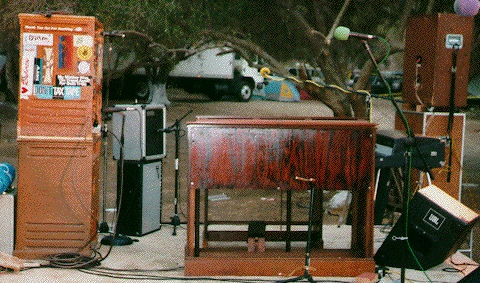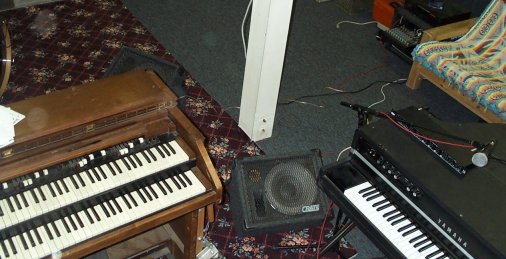













|
updated: 01 Nov 2005
The Quest for the Elusive B-3
I've heard it said that you don't really own a Hammond. They're so over-engineered
that they'll run forever. It's like having a parrot - chances are, it's
going to outlive you, so you don't own it so much as hold it in stewardship.
This, then, is how I became entrusted with the
stewardship of Hammond C-2 s/n 38593. This organ was manufactured in 1950
which means it's over fifty years old. I hope I still rock
this hard when I'm fifty.
I've owned three M-3 spinet Hammonds, and several clones, but I've always
dreamed of owning a console Hammond. The dream was sort of accelerated
by Baja Bash III. At least once per year for the past several years my band
plays at a large outdoor festival near Ensenada, Mexico, called Baja Bash.
The first two bashes it was just my band. For the third one, they added Merl Saunders and the
Rainforest Band. They were playing in Colorado the night before, so for them it was a fly-in
gig. The promoters were handling all the backline, and I was put in charge
of renting a B-3 for the weekend. Because the event was being held in Mexico,
it turned out that it would cost a lot of money to rent one, so instead
I focused on trying to buy one intead. Amazingly, the next week
there was an ad in
 the Reader (weekly rag) for a B-3, Leslie 122, and dollies for $550! I
called about every 15 minutes, couldn't get through.
the Reader (weekly rag) for a B-3, Leslie 122, and dollies for $550! I
called about every 15 minutes, couldn't get through.
It was getting down
to the wire, and I eventually decided to quit hoping for a miracle and just
buy a Hammond from a dealer. I called a local Hammond organ tech
named Bob Blake, and we discussed my dilemma. He had an old Hammond A-102 that he thought would
probably be the most cost-effect solution for me. The A-100 series is essentially
a B-3 in a home-style cabinet. I think there are some differences in the chorus/vibrato
circuit, and the A-100 has its own power amp and speakers, but it's pretty much
the same deal as a B-3. Within the A-100 family, there were various cabinet designs, and the
A-102 was no doubt the silliest of them all by rock and roll standards.
(The A-102 was described as "The Most Hideous Hammond Ever" in Mark Vail's Hammond book "Beauty and the B")
Technically the cabinet style is French Provincial - lots of swoopy woodwork, and it has these dainty little legs in the front.
Yeah, take that on the road and those legs'll be snapping off in no time.
Anyway, whatever, something had to be done, compromises were to be made,
blah blah blah. The reality is, the fact that these home organs are less desirable
than a B-3 can work to your advantage if you happen to be on the buying end of
the deal. Apart from the silly cabinetwork, there's not really anything wrong with these organs -
their most attractive feature might be that they have suffered much less price
inflation simply by virtue of not being a B-3. Still, the B-3 does have
some cachet, not to mention that beautiful four-poster cabinet...
Anyway, I drove over to his shop fully prepared to go home with the A-102. The shop
was located in a small industrial park with roll up steel doors, etc, and you go
inside and it's Hammond heaven! Consoles and Leslies and motors and parts and shit
stacked up everywhere. I don't think I can accurately describe how much stuff
was crammed in there, Think of the last scene in Indiana Jones, except instead of
the Ark of the Covenant, it's just crates and boxes of Hammond organ parts, with
narrow little trails where you could snake your way
through the madness, but only if you were careful not to bump anything and topple
any of the inventory. It was a truly beautiful sight. Bob turned
out to be a really nice guy, in his 70s I figured, and even though his shop was
clogged with this phenomenal backlog he was happy to chat for as long as you
wanted to. So, we get to talking and at some point he indicates to a C-2 maybe
twenty feet away buried under blankets and other stuff. It's an old one,
with the hip old quatrefoil inlays on the side. Very old skool. Then I heard that he'd gotten it from a
Pentecostal church. ("Hey, it's been pre-blessed!" my friend Jerry later said). I don't
know, you just gottta go with your gut feelings on these things, so... that was the last
thought I had about the A-102. Without having played it or heard it or anything I bought
the C-2. It came with the bench (with matching quitrefoil) and pedals. It did not come with
a Leslie, but since
I owned two Leslie 145s aready, it wasn't too much of an issue. We agreed
upon a price, and that was it. I didn't actually take it home that day, because it was set up
for a 122, and Bob needed to convert it to a 147-type interface.
(I was saddened to hear the news of Bob's passing last fall. He was truly
a gentleman in every kind sense of the word. My condolences go out to his
family, friends, and customers. I don't know what we're going to do without him, but
God's B-3 couldn't be in better hands.)
If the A-102 is a first cousin, the B and C series are siblings. (The
Hammond B and C series organs are identical apart from the woodwork.) The
B-3 comes in a four-poster style which looks really cool, and is easier
for four people to carry. Mine, being a C instead of a B has a
church-style cabinet with those quatrefoil inlays on the sides and on the
bench, with a full back that goes all the way down to the floor.
 It also looks cool, but it makes the organ really hard to carry. I wasn't too
into the idea of having to remove the back every time I wanted to move the
organ, so I took the pedals and the back and put them into storage for
safekeeping. For the Mexico trip
I made a back panel out of plywood which I stained and Verathaned, so it
kinda matches, but not really. (I've been meaning to redo it, but it's been,
what, eight years as of this writing and that still hasn't happened yet.)
I also bought a set of Roll-r-Kari dollies which are absolutely indespensible
when it comes to moving these things around.
It also looks cool, but it makes the organ really hard to carry. I wasn't too
into the idea of having to remove the back every time I wanted to move the
organ, so I took the pedals and the back and put them into storage for
safekeeping. For the Mexico trip
I made a back panel out of plywood which I stained and Verathaned, so it
kinda matches, but not really. (I've been meaning to redo it, but it's been,
what, eight years as of this writing and that still hasn't happened yet.)
I also bought a set of Roll-r-Kari dollies which are absolutely indespensible
when it comes to moving these things around.
Since this is a '2' series organ, it was manufactured before Hammond developed
their now-famous key percussion circuit which the B-3 made famous. So, I
had Bob install a
Trek II percussion kit. The Trek II percussion
is interesting in that you get 5th harmonic in addition to 2nd and
3rd, and the volume of each harmonic can be controlled independently using
three little slider things. A fourth slider gives you continuous control of
attack velocity. Pretty cool.
Anyway, that was it. We went to Mexico, and the gig went great. We played
two sets on Friday, and one set Saturday evening and then turned the stage
over to Merl, and I think he played till 3 or 4 in the morning. There was
one weirdness, though. When we were setting up on Friday afternoon the
organ was almost a whole tone flat. At first I thought, OK, maybe the other
guys can tune down, and then I remembered, oh yeah, I've got the Rhodes too.
As you may know, Hammond organs
never need tuning - they get their tuning information from the line current,
which in this country is 60 Hz. The frequency of the juice coming out of your
wall is very strictly regulated, and that's a good thing - the Hammond's
tones are mechanically generated, and inside there's
a synchonous motor (a clock motor, really) which turns the little wheels which
generate the sound. This motor has a little closed-loop control mechanism,
and it relies on the wall current being an accurate 60 Hz. If in fact you're
not getting 60 Hz out of the wall, you're in trouble because the Hammond's pitch
will follow the change in line frequency. The Hammond is pretty robust when
it comes to voltage changes, but AC frequency changes make it go nuts.
It turns out, of course, that portable generators do not have very good frequency
regulation - and on Friday night the show was delayed for about an hour while
we dealt with the generator which was way "flat" - it was putting out fifty-something Hz.
Fortunately, the generator had control panel which displayed frequency and voltage,
so you could read what it was putting out. The frequency was controlled by the generator
motor's throttle position, which was set by this weird linkage. You could take
a wrench and give it a crank, and it would slightly change the motor speed (you could hear
this) and then you could look at the frequency counter and see what happened. If not
for the frequency counter built-in, I don't know what we would have done. I guess
we would have had to tune the generator by ear. We were even more fortunate, because
Don K. (if you're out there you know who you are and thank you again) was kind of enough
to spend the weekend periodically wandering over to the generator and give it a tweak
when it needed it. It got us through the weekend.
Not wanting to relive this particular problem, I have since installed a Trek II
SC-60D-2 frequency reference kit which synthesizes a precise 60.0000 Hz which is
provided to the Hammond's synchronous motor. Now the Hammond is happy in just about
any AC environment. I've heard a horror story about (I think) Melvin Seals' Hammond
going wacko at some outdoor festival up in LA. So, if you play Hammond and you play
outdoor festivals, you need to install one of these kits.
Don't say I didn't warn you.
The next thing to deal with was the ratchet drawbars. Hammond made a great improvement
to the drawbar design in about 1954. Organs made prior to this date (such as mine)
have the "ratchet" style drawbar which are not nearly as cool as the smooth-action
drawbars that came later. With the older drawbars, if
you like to change drawbar registrations on-the-fly, various harmonics drop
out until you stop fiddling with the drawbars. I upgraded my drawbars, and
for those who are interested, here's a
description on what that was like.
The organ is much more fun to play as a result of this conversion.
Lastly, two or three years ago I installed a Trek II spring reverb, which is a lot of fun,
and surprisingly easy to install. Anyway, that's about it. After all this work,
I don't gig with the organ anymore, but I play it often in my home studio whenever
we rehearse. After all these years, it is still the coolest thing in the world. If
I had to chuck every other instrument and only play one more till the end of time,
this would be the one I choose.
 Click on the photo for a
close up look at my Hammond. Click on the photo for a
close up look at my Hammond.
 Here you can see
the Leslies too. Here you can see
the Leslies too.

Apart from its annual trip to Baja Bash, the organ does not see much road time
anymore. It's probably just as well. Here is a photo of it safe at home next
to its good friend the Yamaha CP-70.

COPYRIGHT © 1996-2005 David Chesavage All Rights Reserved |


